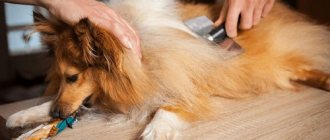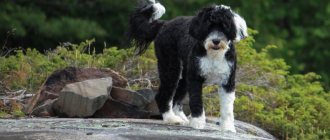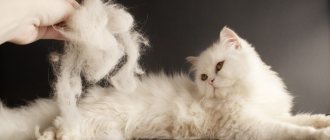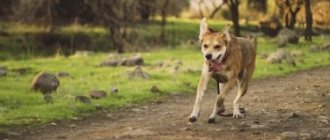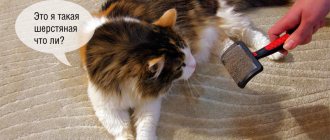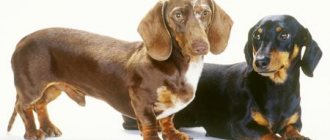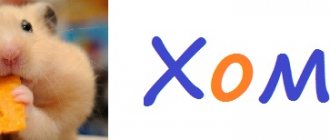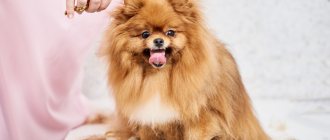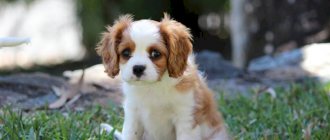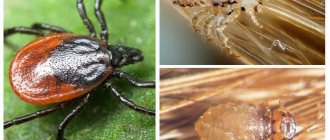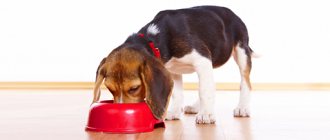The Pomeranian is a small, fluffy animal that barks cutely and asks to play. Everyone wants to have him at home and caress him every day. But ignorance of the care and maintenance of a Spitz can have a detrimental effect on it. The owner must know how to care for the fluffy fur of a Pomeranian Spitz. Spitz shedding comes in different types: natural, which is normal, hormonal, caused by hormonal imbalance, and pathological. Therefore, it is worth understanding in detail how to care for a Spitz’s fur coat, as well as when it is necessary to seek help from a specialist.
What types of molts are there?
There are three types of shedding in the Pomeranian Spitz: age-related (which is divided into children's and junior), seasonal (i.e. at certain times of the year) and hormonal (typical for females). Each type is discussed in more detail below in the article.
Baby shedding
The first coat change in a Pomeranian Spitz puppy occurs at three months. This period lasts at least seven months, that is, the first molt ends at ten months of age. At this time, the puppies begin to grow dense adult hair instead of the delicate baby fluff.
During baby shedding, puppies look quite funny, because it is rare that the loss of fur occurs evenly.
Junior
The junior, or one-year-old, coat change begins a short time after the nursery. It may not begin exactly in a year, but a little earlier or later. Typically this period lasts about two to three months. The dwarf Pomeranian's undercoat, which has grown back after shedding as a child, falls out again. Behind the undercoat, the fur also falls out.
By the age of one and a half years, the Pomeranian grows renewed fur, gradually becoming thicker. And by the age of three, the Pomeranian has already formed a full-fledged adult coat.
Seasonal
Seasonal coat change occurs in spring and autumn. This is due to the hormone melatonin, which is produced due to changes in temperature and length of daylight hours. In the spring, the pet sheds more undercoat, and in the autumn, the main coat grows.
Hormonal
As a rule, hormonal hair loss occurs only in females. This is due to hormonal fluctuations during estrus or during the period of feeding offspring. However, hormonal hair loss has other causes, including:
- lack or excess of estrogen;
- hypothyroidism;
- excess cortisol.
Owner reviews
Violetta: “I never wanted to cut my dog’s hair short, because, in my opinion, such hair is unpleasant to the touch. We once had our ponytail cut short, and at the slightest tactile contact it was noticeable that the smoothness that, say, was on the back had disappeared.”
What and how many times to feed a Spitz - diet analysis
Sasha: “The most amazing thing is that after combing a huge mountain of fur, my dog only becomes fluffier. And even easier. The groomer said that you shouldn't put a harness on a Pomeranian because it creates more tangles in the armpits. But I think it’s better to have tangles than to torment my baby with a collar or a noose.”
Pomeranian Spitz shedding by month
In tabular form, the frequency of coat loss in oranges can be presented as follows:
| Pomeranian puppy age | Shedding type |
| 3-10 months | Children's (At the age of 2 to 4 months, the German Spitz begins its first coat change in its life, lasting 6-7 months) |
| 12-15 months | Junior |
| Every year of life (about 2-3 weeks) | Seasonal (twice a year), hormonal (during the female’s estrus) |
Treatments
To make an animal feel comfortable and look attractive, it is necessary to take care of its fur. And during the molting period, this is the first thing the owner should pay attention to.
However, the Spitz does not like constant care: if you wash and comb it too often, the pet may even get sick. Therefore, it is better to do everything step by step and, most importantly, do not overdo it!
Any care begins with good tools and cosmetics. For a Spitz, it is better to choose the following:
- Combs - massage, with frequent and rare teeth.
- Shampoos, balms for adding shine to wool, specialized sprays against tangles.
- Scissors for maintaining the shape of a haircut, with the help of them you can remove excess hair from the eyes and ears.
The main stages of caring for a Spitz:
- combing;
- bathing;
- drying;
- a haircut.
Combing
To prevent combing from becoming stressful for your Spitz, it is better to accustom him to using a tool from 5 weeks. To do this, place your pet on your knees and gently comb it with a soft brush in the direction of hair growth. It is enough to repeat the procedure twice a week. If you do this more often, you may accidentally remove all the undercoat.
When combing, it is important to pay attention to those places where hair can become matted: ears, armpits, groin area.
During the molting period, it is better to repeat the procedure every day, lightly beating the fur with your hands (this will help remove tangles).
Bathing
It is recommended to bathe your Spitz once every 2 months as it gets dirty. If you do this more often, the animal may begin to itch, develop dandruff, and deteriorate its fur.
For bathing, you should use special shampoos and conditioners. It would be good if they contain additional ingredients that protect against harmful bacteria, improve the color of the coat and give it shine. It is better to choose cosmetics based on your pet’s needs: if he has allergies, opt for a hypoallergenic shampoo; if he is white, purchase whitening rinses for dogs. Shampoos should not be used for humans as they may harm the animal.
It is worth bathing, adhering to the following rules:
- Before water procedures, you should not feed your Spitz.
- You need to take him for a walk first.
- You should comb the slightly wet hair in and against the direction of hair growth.
- Cover the dog's ears with cotton swabs and remove them only at the end of drying.
- Before immersing in water and applying shampoo, it is better to slightly wet the animal's fur.
- The detergent should be carefully distributed over the entire body, except for the animal’s head - shampoo and conditioner should not get into the eyes and ears. After the procedure, you should rinse the coat thoroughly to remove any cosmetic products.
- At the end of bathing, you should wring out the hair well and dry the animal with a towel.
Spitz dogs love to swim, so the owner will have no problems with immersing him in water. But don't overuse it. It is not recommended to frequently wash your Spitz during shedding, as this can cause a large number of mats to form. If the animal is dirty and cannot be bathed, it is better to use dry shampoo for dogs - the aerosol will not harm the animal, it will clean and add shine to the coat.
Drying
After bathing, the Spitz's coat should be dried. If this is not done, your pet may catch a cold and get sick. In addition, moisture can cause bacteria to appear in the animal's fur.
It is recommended to dry with a hair dryer for dogs, which differs from a “human” hair dryer in the presence of a stand and special modes.
It is important to ensure that the stream is not hot, as this can cause skin burns and brittle hair.
While drying, you should comb your pet evenly with a massage comb. It is better to move from the paws to the back. It’s also worth drying the mane: a wide-tooth comb will separate and style your Spitz’s hair beautifully. The procedure ends when the coat is completely dry. At the end, cotton swabs are taken out of the ears.
After bathing and drying, you should not take your pet outside - he can easily catch a cold.
A haircut
The Spitz does not need frequent grooming, as its hair only grows to a certain length. It is best to get a haircut before a dog show at a dog grooming salon. However, the owner can trim the pet’s fur himself.
To do this, it is better to buy scissors with blunt ends: they will protect the animal from damage. With their help you can remove excess hair on the face, ears, and paws. Use small thinning scissors to work out the ears, making the hair on the back and tail thinner.
A neat haircut saves during shedding - it makes the Spitz look more presentable. But you shouldn’t cut your Spitz’s hair with a clipper: his luxurious hair may never return to him again.
How many sheds does a Spitz have per year?
After the final change of the “baby” coat and the formation of a full coat (this happens at three years), the Miniature Spitz changes its coat twice a year: in spring and autumn.
And the female Miniature Spitz sheds during every heat. Pomeranian girls experience especially severe hair loss a couple of months after giving birth. The animal becomes so bald that sometimes it even ceases to look like a Pomeranian. However, this is a temporary phenomenon: the new coat will grow back quite quickly.
The Small Bear-type Pomeranian and the Standard German Pomeranian shed at the same rate.
Features of education
Pomeranians are smart and become attached to their owners. They require constant attention from the owner, you need to play with them, talk - puppies understand intonation and commands.
With a lack of attention, Spitz begin to entertain themselves, gnawing on everything. You can’t blame them for spoiled things; they become aggressive and unsure of themselves.
A dog's behavior depends on what its owner allows it to do. Education must begin at an early age, the puppy should be prohibited from doing anything that an adult pet cannot do later.
Praise and encouragement for correct behavior are required, which kids of this breed adore, but they need to be scolded for misdeeds.
If you allow a Pomeranian to beg during lunch and feed it from the table, it will be difficult to wean an adult dog away from this in the future.
Then, the Spitz perceives refusal of a treat as a punishment, but cannot understand why. The pet becomes nervous and shows dissatisfaction with loud barking.
The Pomeranian has a natural desire to dominate. The use of physical punishment and shouting is strictly prohibited. You need to develop a confident, assertive tone to express your demands.
Spitz coat color during shedding period
Before the first coat change, Pomeranian puppies, as a rule, have a heterogeneous color. Black puppies while shedding become brown, grayish or even gray. Light Pomeranian puppies also become more faded, their fur coat loses its shine and color saturation.
Adult Miniature Spitz dogs of any color also lose the depth of color and brightness of their coat during the period when they begin to shed. Their color does not have a specific shade, but rather resembles a mixture of several. As soon as the orange hair is replaced with a new one, the color will return again, the color will become uniform and monochromatic.
Prevention of baldness
Spitz baldness is a disease that is not difficult to notice. If your pet is losing hair in chunks, you should sound the alarm and contact a veterinarian for help in order to begin treating alopecia in a timely manner. However, all this can be avoided if you carry out preventive measures related not only to caring for the animal’s fur.
Alopecia in a Spitz
Of course, daily brushing and weekly combing of the coat is necessary to prevent the coat from matting. But this is not enough for the good condition of the animal. First of all, you need to take care of the Spitz’s diet. The pet must always have access to drinking water.
Attention! It is necessary to select special food for this breed.
With food, important microelements and vitamins must enter the animal’s body, which will restore hormonal balance and stimulate proper metabolism. This will also allow you not to worry about your pet’s weak immunity, since it will be in normal condition.
In order for a bald animal to once again boast a beautiful shiny coat, you need to understand the cause of alopecia, eliminate it and find out how to properly care for your Spitz. In this case, the pet will be able to compete with other animals at shows.
When to contact a veterinarian
There are a number of signs that indicate a deviation from the norm. If you notice the following symptoms, you should take your pet to a veterinarian:
- the puppy did not change his fluff to an adult one, although he was already one year old;
- little healthy hair is observed. The regrown fur coat is not voluminous, brittle, dry. Its color is dull and unsaturated;
- hair falls out without itching;
- the process of changing the skin is accompanied by frequent and severe itching, inflammation of the mucous membranes of the eyes;
- large bald patches appeared on the pet's body, and the skin in these places acquired a dark tint.
Command training
Given the aggressive and impulsive nature of Pomeranians, discipline is mandatory for them along with active walks. You need to control the animal’s behavior by training it to basic commands:
- "Give!" The pet is easy to learn while playing with the ball. Before you take the toy from him, you need to say the command and praise the puppy.
- "To me!". When walking with a leash, call the dog if it is not busy. The puppy turns towards the voice, slightly pulls the reins and calmly says the command again. Praise after completion.
- “Ugh!”, “No way!” – puppies older than 6 months can be trained to use commands, as they frighten babies. Show the meaning with a sharp, intimidating intonation while pronouncing the command, accompanying it with a jerk of the leash. The movement should not injure the dog.
- "Near!" – learned during a walk, you need to lead the Spitz on a short leash on your left side. When he tries to move to the side, pull him a little towards you, say a nickname and a command. Maintain a calm tone and do not jerk the leash sharply.
- "Place!" needs to be taught in the first months of life. Say the command with praise and pet the puppy when he goes to his bed after eating. If the Spitz decides to settle somewhere else, say the command and take him to his place. It should be arranged so that the baby feels comfortable and protected, this promotes quick memorization.
All commands, except for the prohibiting one, must be spoken in a gentle tone, otherwise the dog will perceive them as punishment. If done, praise and treat with a treat.
A Pomeranian Spitz is suitable for active owners - the puppies are very active, willingly spend time with their owner, become attached to him and become true friends.
Caring for a puppy and an adult dog during the shedding period
During this period, the dog requires careful care. The main thing that needs to be done is combing. This procedure is necessary for two reasons:
- with active combing of the fur coat, the duration of molting is reduced;
- Thanks to improved blood circulation, combing stimulates the growth of new hairs.
For proper combing you will need:
- a special comb, slicker brush or furminator;
- You need to comb your pet every other day, once at a time. Daily brushing is not prohibited. This must be done within fifteen minutes;
- You need to comb it carefully so that tangles do not form on your new coat in the future;
- movements must be performed from the tail to the head, that is, against the growth of the hair.
How to deal with shedding in Spitz dogs
Why do cats sleep a lot: the main reasons and is it normal?
The most popular question asked to breeders is whether a Spitz has a lot of hair. People often think that during shedding, the whole house is covered in animal fluff. However, if you brush your pet regularly, all the fallen hairs will end up on the bristles of the slicker.
During the procedure, it is worth placing the animal on a special table for grooming or any other device separately designed for this. After combing, it is recommended to vacuum the room so that the wool does not fly around the apartment.
Vitamin therapy for dogs during shedding
When a dog goes through a molting period, it needs more vitamins and minerals. The main vitamin for the growth of a healthy and thick coat is vitamin D. For shedding Miniature Spitz dogs, special vitamin complexes are produced that help the animal ease this period, giving the growing coat more shine and thickness. A complex containing vitamins A, B, C, D and E would be suitable.
Micro- and macroelements, the consumption of which should be increased, include:
- Calcium.
- Magnesium.
- Copper.
- Phosphorus.
- Zinc.
In addition, it is necessary to add more fatty amino acids (omega-3, omega-6) to the diet of a shedding animal.
Basics of training
First of all, you need to accustom the puppy to his name, calling it during rewards. Pomeranians remember their name very easily.
- The next task is litter box training. Puppies quickly become accustomed to proper hygiene, but a little patience is required at first.
First, they place several trays where the baby relieves himself; for the smell, you need to leave diapers soaked in the puppy’s urine in them, which are periodically replaced.
After a few days, the trays are washed and gradually moved to a corner designated specifically for the toilet. After another 7-8 days, the excess trays are removed.
To quickly accustom your baby to the toilet, you need to put him there after eating and sleeping. If he sniffs and searches, take the baby to the tray. After the “deed”, praise and treat him with something delicious.
What should you not do during the molting period?
If your pet undergoes its first coat change, it should not be washed or bathed. Due to water procedures, your pet's coat will become matted and tangles will form that will be impossible to comb through.
Another prohibition is cutting the Miniature Spitz. While the Pomeranian is shedding, it cannot be cut. This will cause the guard hair to become very thin and baldness will begin.
General information
Spitz are very similar to small fluffy bears. The coat is soft and thick, they have a very dense undercoat. The guard hair covers the neck, paws, tail and body. The undercoat consists of thick, soft hair that adheres very closely to the dog's skin.
During age, Spitz dogs begin to look shabby and unkempt, but this is a natural process that all dog owners of this breed should be aware of. Hair growth on your pet's body goes through a certain cycle. Initially, it begins its development from the follicle. Under the influence of external factors, the hair receives certain damage, its bulb is destroyed. During shedding, hair loss occurs. Then a new one begins to grow in its place.
Shedding in a Spitz becomes most noticeable during the age-related change in coat. Animals that do not participate in the reproduction of their offspring and live in warm apartments shed almost unnoticed by the owner.
Let us list the main reasons why Spitz sheds.
Vitamins for wool
Specialized vitamin and mineral complexes for fur will help restore and continue to maintain your pet’s radiant appearance.
There are products for internal and external use (lotions, fortified oils).
- Farmavit Neo: given for impaired pigmentation, long shedding, peeling and itching, during pre-show preparation.
- Omega Neo+ “Shiny Wool”: immediately contains omega-3 acids, biotin and brewer’s yeast (a source of B vitamins).
- Beaphar Doggy's Biotine: recommended for long-haired breeds, improves the appearance of the coat.
- Russian preparations “Tsamaks”, “Stol”, “Rial”, “Spirulin” will add richness and brightness to the red color.
- Fortified treats Sanal Yeast Calcium, 8in1 Brewers Yeast, 8in1 Nutricoat: promote the growth and strengthening of fur, “raise” the undercoat.
- Veda Phytomins: functional food, recommended for dogs prone to pathological baldness (fungi, parasites, allergies, etc.).
Injury
Dogs with long floppy ears are often injured. When they are serious, they are noticed by the owner immediately; and minor ones, in which there is no hematoma or bleeding, are usually not detected quickly. They become noticeable only if a translucent yellowish crust forms at the site of minor scratches or cuts.
If it is accidentally torn off, there is almost always no bleeding, and only a clear, slightly yellowish liquid is released. For treatment, simply treat the affected area with an antiseptic. After the wounds heal, the scabs will fall off. For this reason, crusts on the tips of a dog's ears may appear regularly.
Drug therapy
Prescribed in the initial stages or as an additional treatment. Consists of:
- Bathing with antifungal shampoo. Fungi do not always cause black skin disease, but often affect exposed areas. The Miniature Spitz needs to be washed once every 3 days, the course duration is 1 month. Then change the shampoo to tar. Be sure to use a moisturizing conditioner.
- Vaccinations against ringworm. Pomeranians are vaccinated with Polivak-TM serum.
- Getting rid of parasites. Deworming and flea and tick treatment are carried out.
- Strengthening the immune system. Vitamins and probiotics are prescribed. The drug “PDE” is also recommended - denatured emulsified placenta. A natural product that contains all the necessary vitamins, elements, and amino acids. Used in the form of tablets, injections or powder for rubbing into the skin.
Additional warning symptoms
If your dog starts shedding intensively and not according to schedule, this can be explained by dozens of natural reasons. If shedding began due to health problems, the pet will experience additional alarming symptoms.
The dog has dandruff
Contrary to popular belief, dandruff is not the same as flaking skin. Dandruff or something similar to it can be a symptom of:
- Fungal skin infection.
- Infections with skin parasites.
- Metabolic disorders.
- Improper functioning of the skin glands.
Unfortunately, the origin of dandruff is almost impossible to determine at home. Metabolic disorders mean several dozen abnormalities, the most common of which are:
- Food allergies.
- Flea dermatitis.
- Non-food allergies.
- Unbalanced diet.
If your dog has dandruff and its amount is constantly increasing, it is recommended to immediately contact a veterinary clinic. The doctor will take skin scrapings and examine them under a microscope. Promptness is important because the dandruff you see may be the result of parasites.
Scratching appeared
Scratching appears if the dog suffers from itchy skin. Hair loss can occur before itching occurs or as a result of constant scratching. Itching, leading to the formation of scallops and baldness, can be caused by:
- Subcutaneous mites.
- Fleas.
- Allergic reaction.
- Hormonal disorders.
- Skin diseases of various origins.
The danger of scratching is the risk of secondary infection. When pathogenic bacteria enter injured skin, an inflammatory process begins, the development of which is difficult to predict. Scratching needs to be treated, even if the cause is unknown. To accelerate tissue regeneration, local, symptomatic therapy is used. To eliminate itching until an accurate diagnosis is established, antihistamines are used.
Skin sores
Various sores on the skin can form as a result of scratching or serve as a symptom:
- Infection with skin parasites.
- Fungal infection.
- Dermatitis caused by improper feeding or care.
One of the most common and difficult (in terms of treatment) skin sores in dogs is eczema. Eczema is divided into dry and wet. Dry eczema responds better to treatment and heals faster. Wet eczema is not immediately detected because long-haired dogs are prone to it. Most often, at the time of detection of eczema, a secondary infection occurs, which leads to an inflammatory process.
Tags
Pomeranian Spits of the German Spits of the Pomeranian Spitz further than a ponsian spitz Spitz were a dog with a strong -elastic dog of a dog of a dog with a worshiping dog of a dog VOU Dog is a declinatory dog. For dogs, a long -haired dog. The adhesive dog mols is a molting of the reduced molting. Style Swims of wool can be a breed Representatives of this breed resemble a purebred Spitz. This breed is shed Pomeranian dog breeds are fluffy breeds. Dog breeds
feedseasonalarticlemenuhairsespeciallypermanentsuchcomment lengthsmanyvolumebatheterriermeansphoto
Related products
Hill's Science Plan Kitten Chicken to support immunity and healthy digestion. A diet with clinically proven antioxidants and optimal levels of DHA (docosahexaenoic acid) from fish oil. Antioxidants with clinically proven effects to support immune systems. Maintains the health of vital organs through the correct balance of sodium and phosphorus. 100% guarantee of quality, consistency and taste.
PREGNANCY AND LACTATION, KITTENS (up to 1 year), KITTENS (up to 1 year), KITTENS (up to 1 year), KITTENS (up to 1 year), KITTENS (up to 1 year), KITTENS (up to 1 year)
Hill's Science Plan Kitten with Tuna to support immunity and healthy digestion. A diet with clinically proven antioxidants and optimal levels of DHA (docosahexaenoic acid) from fish oil.
Kittens need to receive the correct amount of different nutrients for healthy growth and development. These nutrients must be precisely balanced because too much of a nutrient can be just as harmful as too little.
It is also important to use high-quality ingredients to help digestion, which is especially sensitive at this age. Hill's Science Plan diets provide precisely balanced nutrition to meet your kitten's individual needs, eliminating any nutritional deficiencies or excesses.
Drying
After bathing, Spitz dogs need to be dried. A puppy or adult dog is dried using a special hair dryer. During drying, the air flow should not be hot, otherwise the dog may get burned. First you need to dry your limbs well, and after that we move on to the sides and back. When drying your mane, you should use a comb. With its help, wool dries very well. After drying, cotton swabs should be removed from the animal's ears. Now you can comb your pet, giving its fur the desired volume.
Cockapoo
Cockapoos are created by crossing a miniature poodle and a cocker spaniel. Cockapoos are very popular with families due to their loving and friendly nature. These teddy bear dogs are great with other pets and children, making them ideal pets for the whole family.
One thing that is particularly attractive about Cockapoos is that they are all unique and come in different sizes and colors. These dogs are energetic and need plenty of daily exercise, which should include mental stimulation as these puppies love to learn.
A healthy cockapoo can live up to 18 years. However, this breed can be prone to several health problems: luxating patella, hip and elbow dysplasia.
